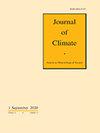An increase in autumn marine heatwaves caused by the Indian Ocean Dipole in the Bay of Bengal
IF 4
2区 地球科学
Q1 METEOROLOGY & ATMOSPHERIC SCIENCES
引用次数: 0
Abstract
Abstract This study investigates the interannual variability of Marine Heatwaves (MHWs) in the Bay of Bengal (BOB) associated with the Indian Ocean Dipole (IOD) from 1982 to 2021. The results revealed a significant positive correlation at the 95% confidence level between the IOD and MHW days in the central bay at the peak of the IOD in autumn. During positive IOD (pIOD) events, the central bay experienced more MHW days in autumn, with an average increase of 7.4 days. The increased MHW days in the central bay could be primarily attributed to the enhanced net heat flux (TQ), which is 9.7 times the contribution of ocean dynamic processes (horizontal advection + entrainment). The reduced latent heat flux loss and enhanced shortwave radiation due to the anomalous atmospheric low-level high pressure associated with the pIOD account for 63% and 50%, respectively, of the anomalous enhanced TQ, while the longwave radiation and sensible heat flux make smaller contributions of −20% and 7%. In addition, thermocline deepening in the southwestern bay, caused by this anomalous high pressure and associated anticyclonic wind anomalies, favors the occurrence and persistence of MHWs by reducing the mixed-layer cooling rate. In addition to the influence of the IOD, the El Niño-Southern Oscillation mainly affects MHWs from winter to the following summer, which confirms the result of a previous study.孟加拉湾印度洋偶极子导致秋季海洋热浪增加
摘要 本研究调查了 1982 年至 2021 年孟加拉湾海洋热浪(MHWs)与印度洋偶极子(IOD)的年际变化。研究结果表明,在秋季印度洋偶极子的高峰期,印度洋偶极子与孟加拉湾中部的海洋热浪日数在 95% 的置信水平上存在明显的正相关。在正 IOD(pIOD)事件期间,中部海湾秋季的 MHW 日数增加,平均增加 7.4 天。中部海湾 MHW 日数增加的主要原因是净热通量(TQ)增加,是海洋动力过程(水平平流 + 夹带)贡献的 9.7 倍。与 pIOD 相关的异常大气低层高压导致的潜热通量损失减少和短波辐射增强分别占异常增强 TQ 的 63% 和 50%,而长波辐射和显热通量的贡献较小,分别为-20%和 7%。此外,由异常高压和相关反气旋风异常引起的西南海湾热跃层加深,通过降低混合层冷却率,有利于 MHWs 的出现和持续。除了 IOD 的影响外,厄尔尼诺-南方涛动主要影响冬季至次年夏季的 MHWs,这证实了先前研究的结果。
本文章由计算机程序翻译,如有差异,请以英文原文为准。
求助全文
约1分钟内获得全文
求助全文
来源期刊

Journal of Climate
地学-气象与大气科学
CiteScore
9.30
自引率
14.30%
发文量
490
审稿时长
7.5 months
期刊介绍:
The Journal of Climate (JCLI) (ISSN: 0894-8755; eISSN: 1520-0442) publishes research that advances basic understanding of the dynamics and physics of the climate system on large spatial scales, including variability of the atmosphere, oceans, land surface, and cryosphere; past, present, and projected future changes in the climate system; and climate simulation and prediction.
 求助内容:
求助内容: 应助结果提醒方式:
应助结果提醒方式:


